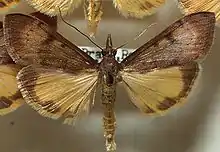Uresiphita gilvata
Uresiphita gilvata is a moth of the family Crambidae. It was first described by Johan Christian Fabricius in 1794 and is found in Europe and North Africa.
| Uresiphita gilvata | |
|---|---|
 | |
 | |
| Scientific classification | |
| Kingdom: | |
| Phylum: | |
| Class: | |
| Order: | |
| Family: | |
| Genus: | |
| Species: | U. gilvata |
| Binomial name | |
| Uresiphita gilvata (Fabricius, 1794) | |
| Synonyms | |
| |
The wingspan is 29–37 mm. The forewing is greyish to light brown sometimes whitish bands either side of the median area (sometimes obsolete).The hindwing is pale or bright yellow with a black margin. The lines vary from faint to clear. The postmedian line is undulating and the antemedian line is almost straight.
Adults are on wing from September to October depending on the location.
The larva feed on various low-growing herbaceous plants, including Genista, Cytisus and Ulex.
It is listed as a synonym of Uresiphita polygonalis by some sources.[1]
References
- Beccaloni, G.; Scoble, M.; Kitching, I.; Simonsen, T.; Robinson, G.; Pitkin, B.; Hine, A.; Lyal, C., eds. (2003). "Uresiphita polygonalis". The Global Lepidoptera Names Index. Natural History Museum. Retrieved April 23, 2018.
External links
 Media related to Uresiphita gilvata at Wikimedia Commons
Media related to Uresiphita gilvata at Wikimedia Commons- "63.011 BF1369 Uresiphita gilvata (Fabricius, 1794)". UKMoths
This article is issued from Wikipedia. The text is licensed under Creative Commons - Attribution - Sharealike. Additional terms may apply for the media files.